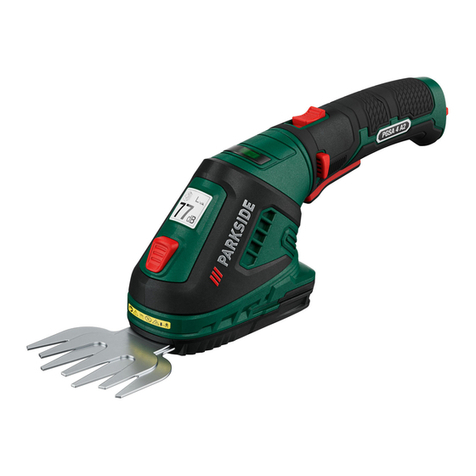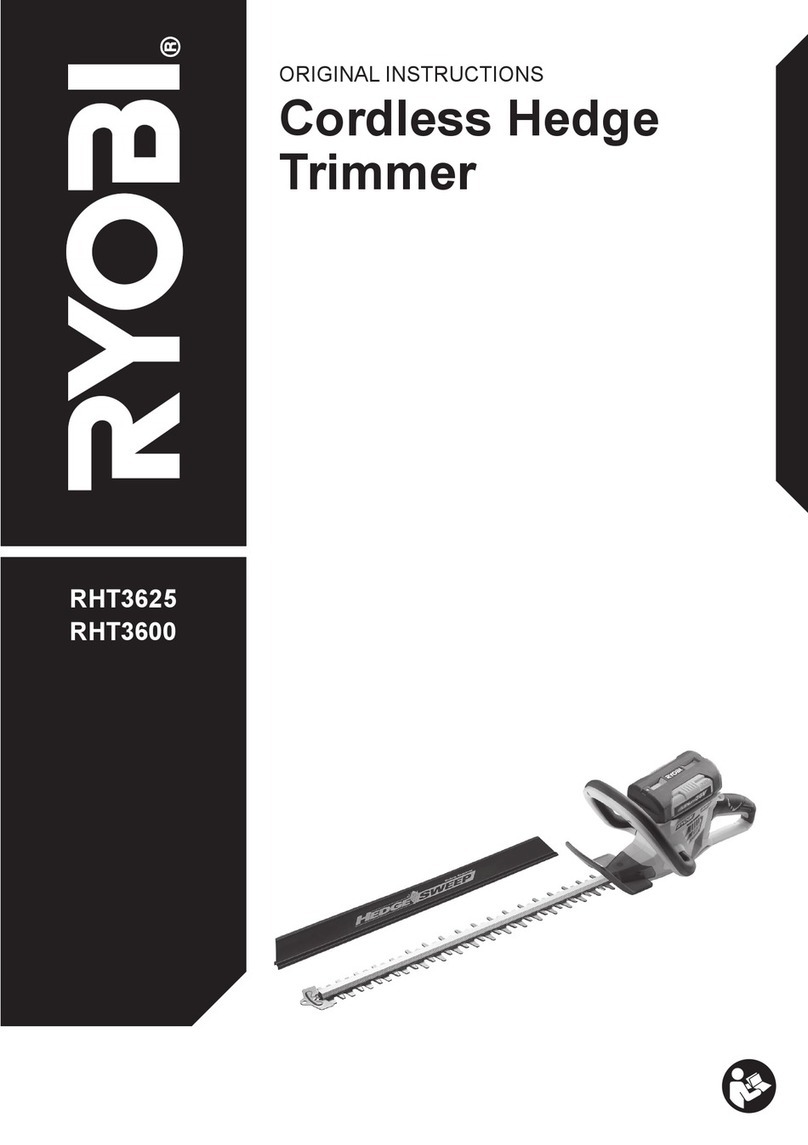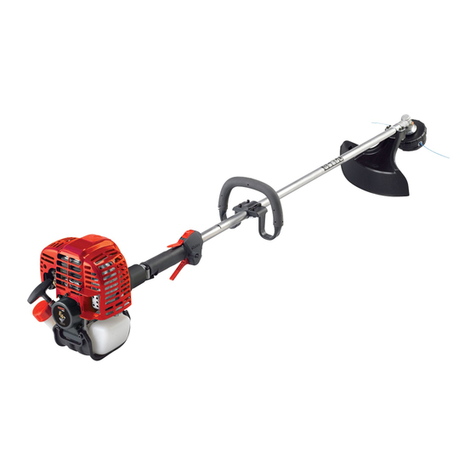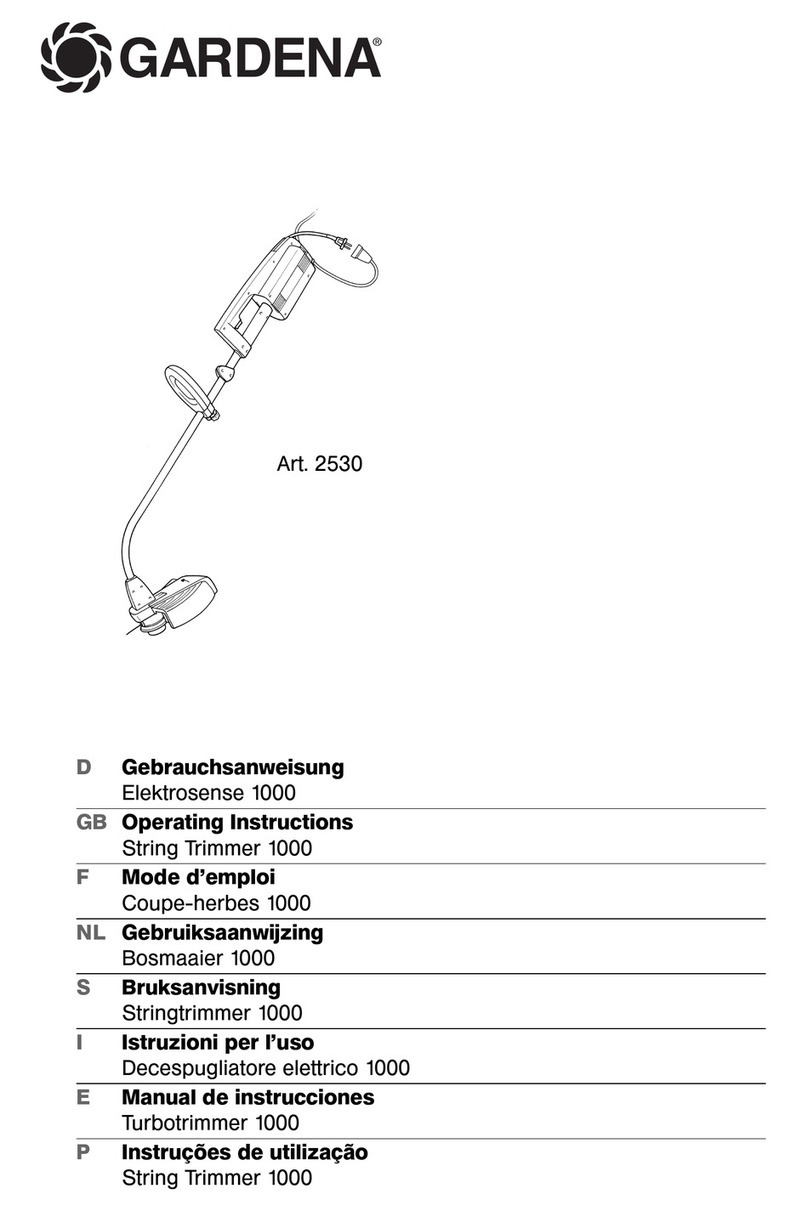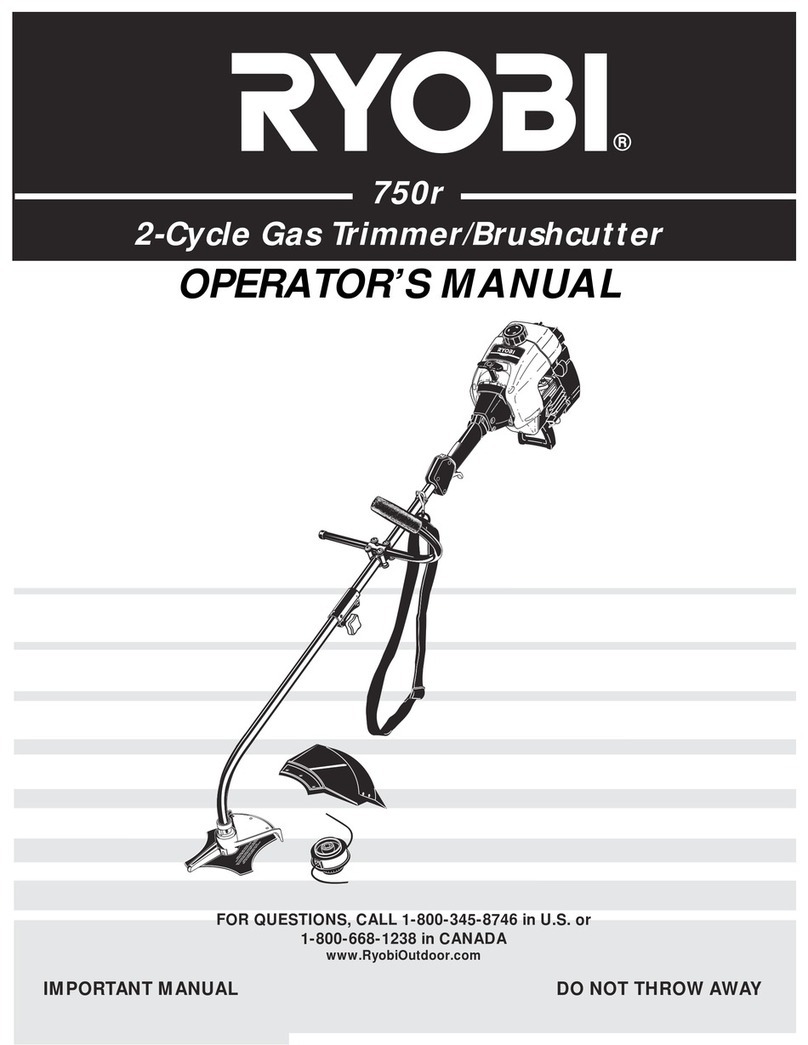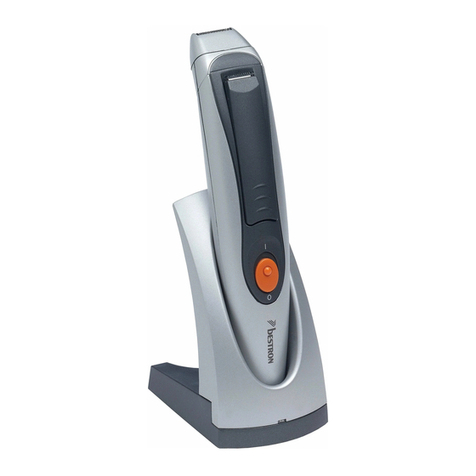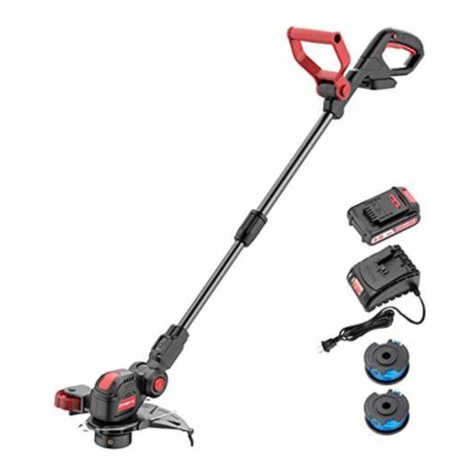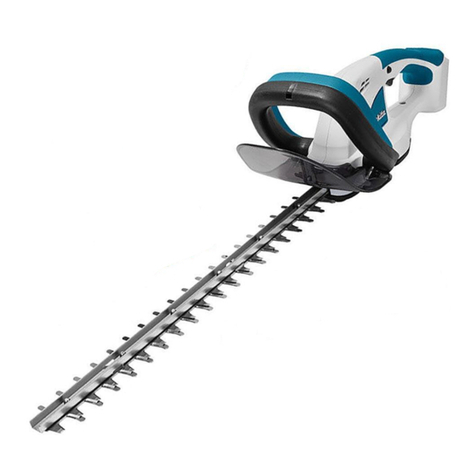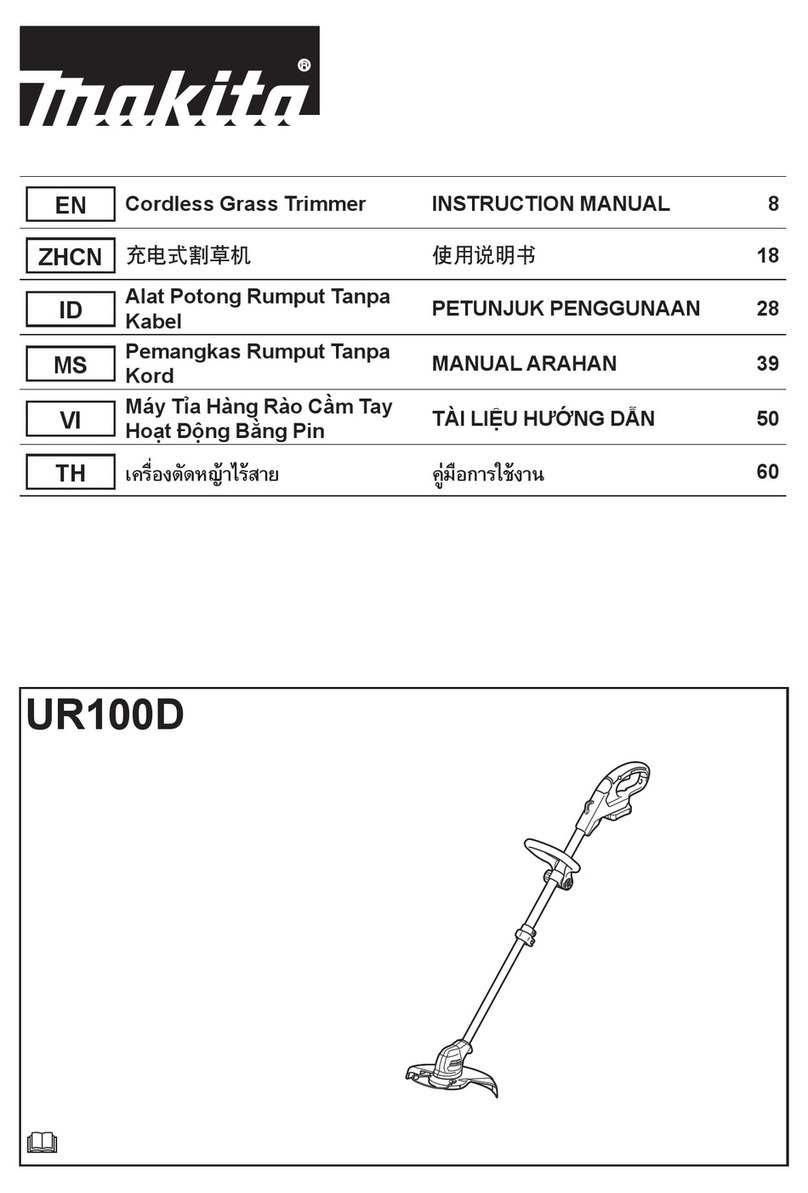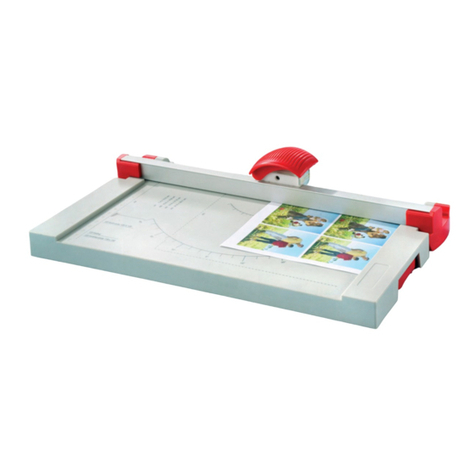Stout Designs TRAILBLAZER User manual

2020
TRAILBLAZER - Operation Manual
Stout Designs, LLC
1/1/2020
TRAILBLAZER –OWNER’S MANUAL

Operating tips: VERY IMPORTANT
• Always run TRAILBLAZER at full throttle when cutting.
• Make sure the kill switch somewhere close to you so you can shut the machine down in the event you need to. (i.e. if you
get the saw in a bind or your around bystanders.)
• If you get the saw in bind and the belts slip or start stalling the motor, the first reaction you should have is to reverse
backwards or use the kill switch.
• Always walk away from the blade side while the blades are running.
• Don't let debris build up to heavy on top of the motor as the debris could get hot and ignite if left on top of the engine.
• Try to always use 91 or better non-ethanol fuel.
• Always tighten your blades with an impact wrench. A hand wrench will not tighten them enough.
• Never tighten the set screw on the clutch assembly jaw coupling (this coupling is designed to slip if needed). All other
setscrews on the bearings, drive shaft jaw coupling and clutch housing can be tightened and should be checked prior to use.
picture of setscrew to never tighten to follow.
• Visually Check to make sure Blue Spider is locked in place as shown in picture to follow
Note: if used on public trails, roads or pathways, please always use with caution and always use a lead and
trail vehicle to alert any potential oncoming public vehicles that trail maintenance equipment is near.


BLUE SPIDER PROPERLY ENGAGED.
TURN STAINLESS STEEL RING TO
THIS POSITION IF FOR SOME REASON
IT IS NOT.

TRAILBLAZER
US PAT. D795,307
US PAT. 9,807,928
VERTICAL TRAIL TRIMMER
OPERATOR / SAFETY MANUAL
!WARNING!
Note the following before starting:
Please read the operator's manual carefully.

INTRODUCTION
Dear Customer,
Congratulations on your choice to buy a Stout Designs, LLC product!
Today Stout Designs, LLC is striving to be one of the leading manufacturers in the world of
forest coppicing products for use on ATV’s, UTV’s, Golf Carts and small tractors, with quality
as our highest priority. The business concept is to develop, manufacture and market motor-driven
products for forestry and trail management. Stout Designs’ aim is to develop equipment that
insures ergonomics, usability and environmental protection.
We are confident that you will appreciate, with great satisfaction, the quality and performance of
our product for a very long time to come. The purchase of one of our products gives you access
to one of the most innovative products in trail/pathway clearing and limb/brush management
along with professional help with repairs and service if it ever becomes necessary. If the retailer
who sells your machine is not Stout Designs, LLC or one of our authorized dealers, ask for the
address of your nearest service dealer or the product can be returned to Stout Designs, LLC for
any repair needs.
It is our wish that you will be satisfied with your product and that it will be your companion for a
long time. Think of this operator′s manual as a valuable document. By following its content
(usage, service, maintenance, etc.), the life span and the second-hand value of the machine can
be extended. If you sell this machine, make sure that the operator′s manual is passed on to the
buyer.
Thank you for using a Stout Designs, LLC product.
Stout Designs, LLC has a policy of continuous product development and therefore reserves the
right to modify the design and appearance of products without prior notice.

! WARNING !
The machine is designed for trimming horizontally orientated overhanging branches 2” in
diameter or less along forestry trails, pathways and roads and is to be used only when area is
clear of bystanders, fellow workers or animals.
The only accessories you can operate with this equipment are ones provided by Stout Designs,
LLC and specifically designed for your exact unit.
Never use the machine if you are tired, if you have drunk alcohol, or if you are taking medication
that could affect your vision, your judgement or your co-ordination.
Shut down equipment engine prior to exiting the vehicle and visually ensure the blades have
stopped completely.
Ideal operating speed for the saw is 3200-3600 RPM. Although the saw will run at a higher
RPM the motor is designed to operate at a maximum RPM of 3600 and actually produces the
most torque between 3200-3600 RPM. Blades will begin to rotate at an RPM greater than 2000
RPM.
Wear personal protective equipment. See instructions under the “Personal protective equipment”
heading.
Never use a machine that has been modified in any way from its original specification.
Never use a machine that is faulty. Carry out the checks, maintenance and service instructions
described in this manual. Some maintenance and service measures must be carried out by trained
and qualified specialists. See instructions under the Maintenance heading.
All covers, guards and handles must be fitted before starting. Ensure that the spark plug cap and
ignition lead are undamaged to avoid the risk of electric shock.
The machine operator must ensure that no people or animals come closer than 20 feet while
working. When several operators are working in the same area the safety distance should be at
least 50 feet.
Carry out an overall inspection of the machine before use. See the maintenance schedule. In
addition to this manual, a Service manual from the MOTOR manufacturer will be provided.

! WARNING !
Long-term exposure to noise can result in permanent hearing impairment. So always use
approved hearing protection.
! WARNING !
Under no circumstances may the design of the machine be modified without the permission
of the manufacturer. Always use original accessories. Non-authorized modifications and/or
accessories can result in serious personal injury or the death of the operator or others.
! WARNING !
A TRAILBLAZER can be dangerous if used incorrectly or carelessly, and can cause
serious or fatal injury to the operator or others. It is extremely important that you read
and understand the contents of this operator’s manual.
! WARNING !
Running an engine in a confined or badly ventilated area can result in death due to
asphyxiation or carbon monoxide poisoning.
! WARNING !
You must use approved personal protective equipment whenever you use the machine. Personal
protective equipment cannot eliminate the risk of injury but it will reduce the degree of injury if
an accident does happen. Ask your dealer for help in choosing the right equipment if questions
arise.
HEAD PROTECTION
Head protection should whenever you operate an ATV of any kind. Protecting yourself from
potential head injuries is a key element of safe equipment operation. A head injury can impair
you for life or it can be fatal. Wearing a safety helmet or hard hat is one of the easiest ways to
protect an your head from injury. Hard hats can protect yourself from impact and penetration
hazards as well as from electrical shock and burn hazards. For your protection, head protection

must be worn if the trees being cleared are taller than 2 m. Approved head protection must
comply with the ANSI Z89.1.
HEARING PROTECTION
Wear hearing protection that provides adequate noise reduction. Generally, the louder the noise,
the shorter the exposure time before hearing protection is required. For instance, you may be
exposed to a noise level of 90 dB for 8 hours per day (unless they experience a Standard
Threshold Shift) before hearing protection is required. On the other hand, if the noise level
reaches 115 dB hearing protection is required if the anticipated exposure exceeds 15 minutes.
For a more detailed discussion of the requirements for a comprehensive hearing conservation
program, see OSHA Publication 3074 (2002), “Hearing Conservation” or refer to the OSHA
standard at 29 CFR 1910.95, Occupational Noise Exposure, section (c).Approved devices should
have a NRR (Noise Reduction Rating) of 20db.
!WARNING!
Listen out for warning signals or shouts when you are wearing hearing protection. Always
remove your hearing protection as soon as the engine stops.
EYE & FACE PROTECTION
Always wear approved eye protection. Face protection should be worn whenever possible.
Protective eyeglasses have safety frames constructed of metal or plastic and impact-resistant
lenses. Side shields are available on some models. Face shields are transparent sheets of plastic
that extend from the eyebrows to below the chin and across the entire width of your head. Some
are polarized for glare protection. Face shields protect against nuisance dusts and potential
splashes or sprays of hazardous liquids but will not provide adequate protection against impact
hazards. Face shields used in combination with goggles or safety spectacles will provide
additional protection against impact hazards. Wearing face protection does not adequately
protect your eyes; you must also wear approved eye protection. Approved eye protection must
comply with the ANSI Z87.1.

GLOVES
Gloves should be worn when necessary, e.g. when fitting cutting attachments. If a hazard
assessment reveals that you face potential injury to hands and arms that cannot be eliminated
through engineering and work practice controls, you must ensure that you wear appropriate
protection. Potential hazards include skin absorption of harmful substances, chemical or thermal
burns, electrical dangers, bruises, abrasions, cuts, punctures, fractures and amputations.
Protective equipment includes gloves, finger guards and arm coverings or elbow-length gloves.
You should explore all possible engineering and work practice controls to eliminate hazards and
use PPE to provide additional protection against hazards that cannot be completely eliminated
through other means. For example, machine guards may eliminate a hazard. Installing a barrier
to prevent you from placing their hands at the point of contact between a table saw blade and the
item being cut is another method.
FOOT PROTECTION
Wear boots with steel toe-caps and non-slip sole. Safety footwear must meet ANSI minimum
compression and impact performance standards in ANSI Z41-1991 (American National Standard
for Personal Protection-Protective Footwear) or provide equivalent protection. Footwear
purchased before July 5, 1994, must meet or provide equivalent protection to the earlier ANSI
Standard (ANSI Z41.1-1967). All ANSI-approved footwear has a protective toe and offers
impact and compression protection. But the type and amount of protection is not always the
same. Different footwear protects in different ways. Check the product’s labeling or consult the
manufacturer to make sure the footwear will protect the user from the hazards they face.
Approved foot protection must comply with the ANSI Z41.1.
CLOTHING
Wear clothes made of a strong fabric and avoid loose clothing that can catch on twigs and
branches. Always wear heavy, long pants. Do not wear jeweler, shorts, sandals or go barefoot.
Secure hair so it is above shoulder level.
FIRST AID KIT
Always have a first aid kit nearby.

! WARNING !
All servicing and repair work on the machine requires special training. This is especially true of
the machine′s safety equipment. If your machine fails any of the checks described below you
must contact your service agent. When you buy any of our products we guarantee the availability
of professional repairs and service. If the retailer who sells your machine is not a servicing
dealer, ask him for the address of your nearest service agent.
!WARNING!
Never use a machine with faulty safety equipment. The machine's safety equipment must
be checked and maintained as described in this section. If your machine fails any of these
checks contact your service agent to get it repaired.
!WARNING!
Never use a cutting attachment without an approved guard. If an incorrect or faulty guard
is fitted this can cause serious personal injury.
!WARNING!
Overexposure to vibration can lead to circulatory damage or nerve damage in people who
have impaired circulation. Contact your doctor if you experience symptoms of
overexposure to vibration.
Such symptoms include numbness, loss of feeling, tingling, pricking, pain, loss of strength,
changes in skin color or condition. These symptoms normally appear in the fingers, hands
or wrists. The risk increases at low temperatures.
!WARNING!
Mufflers fitted with catalytic converters get very hot during use and remain so for some
time after stopping. This also applies at idle speed. Contact can result in burns to the skin.
Remember the risk of fire!
!WARNING!
The inside of the muffler contain chemicals that may be carcinogenic. Avoid contact with
these elements in the event of a damaged muffler.

!WARNING!
Bear in mind that:
The exhaust fumes from the engine are hot and may contain sparks which can start a fire.
Never start the machine indoors or near combustible material!
CUTTING EQUIPMENT
! WARNING !
TRAILBLAZER blades are laser cut and specially designed to optimize cutting efficiency. These
blades need to be replaced by TRAILBLAZER blades only. Replacing blades with any other
type of blade will void your warranty and could cause serious injury and possible death to the
operator and or others.
!WARNING!
Always stop the engine before doing any work on the cutting attachment. Keep in mind the
blades will continue to rotate even after the throttle has been reduced below 2200 rpm or
engine has turned off. Visually insure that the cutting have stopped completely before
exiting the vehicle.
!WARNING!
Using an incorrect cutting attachment or an incorrectly sharpened blade increases the risk
of blade thrust.
!WARNING!
Always discard a blade that is bent, twisted, cracked, broken or damaged in any other way.
Never attempt to straighten a twisted blade so that it can be reused. Only use original
blades of the specified type.

FUEL SAFETY
Never start the machine if one of the following conditions are noted:
If you have spilt fuel on it. Wipe off the spillage and allow remaining fuel to evaporate.
If you have spilt fuel on yourself or your clothes, change your clothes. Wash any part of
your body that has come in contact with fuel. Use soap and water.
If the machine is leaking fuel. Check regularly for leaks from the fuel cap and fuel lines.
TRANSPORT AND STORAGE
Store and transport the machine and fuel so that there is no risk of any leakage or fumes
coming into contact with sparks or naked flames, for example, from electrical machinery,
electric motors, electrical relays/ switches or boilers.
When storing and transporting fuel always use approved containers intended for this
purpose.
Ensure the machine is cleaned and that a complete service is carried out before long-term
storage.
The ORANGE transport guard must always be fitted to the cutting attachment when the
machine is being transported or in storage.
Secure the machine during transport.
!WARNING!
Take care when handling fuel.
Bear in mind the risk of fire, explosion and inhaling fumes.
!WARNING!
Fuel and fuel fumes are highly inflammable and can cause serious injury when inhaled or
allowed to come in contact with the skin. For this reason observe caution when handling
fuel and make sure there is adequate ventilation.
!WARNING!
The catalytic converter muffler gets very hot during and after use. This also applies during
idling. Be aware of the fire hazard, especially when working near flammable substances
and/or vapors.

DURING FUELING
!WARNING!
Taking the following precautions, will lessen the risk of fire:
Mix and pour fuel outdoors, where there are no sparks or flames.
Do not smoke or place hot objects near fuel.
Always shut off the engine before refueling.
Always stop the engine and let it cool for a few minutes before refueling.
When refueling, open the fuel cap slowly so that any excess pressure is released gently.
Tighten the fuel cap carefully after refueling.
Always move the machine away from the refueling area and source before starting.
Always use a fuel container with an anti-spill valve.
If you have spilt fuel on it, wipe off the spillage and allow remaining fuel to evaporate.
Clean the area around the fuel cap. Contamination in the tank can cause operating
problems.
ITEMS TO CHECK BEFORE STARTING
Check the blade to ensure that no cracks have formed at the bottom of the teeth or by the
center hole. The most common reason why cracks are formed is that sharp corners have
been formed at the bottom of the teeth while sharpening or that the blade has been used
with dull teeth. Discard a blade if cracks are found and only use approved replacement
blades.
Check that the support flange is not cracked due to fatigue or due to being tightened too
much. Discard the support flange if it is cracked.
Ensure the locking nut has not lost its captive force.
All saw blade lock nuts should be torqued to 266 ft-lbs.
Check that the belt and shaft guards are not damaged, loose or missing. Replace any
guards if they have been exposed to impact or have been damaged.
Never use the machine without a guard nor with a defective guard.
All covers must be correctly fitted and undamaged before you start the machine.
Remove orange blade cover. Replace blade cover at any time when machine is not
in use to prevent accidental injury from contact with the blade teeth.
TO START:
Check your surroundings. If all is clear, while seated on your ATV, raise the throttle up
approximately ¼”, pull choke out and pull start engine. Once engine starts, push choke
in and all engine to idle at less than 2000 RPM. When you are ready to cut, reach up and
increase throttle to around 3200-3600 RPM and proceed to cut brush and limbs.

CRITICAL OPERATION WARNINGS:
Never operate TRAILBLAZER at vehicle speeds greater than 5 mph while cutting and
slower speeds may be required when brush is really thick.
Always be aware of your surroundings not only for bystanders, animals, but also for the
terrain in which you are operating the ATV & TRAILBLAZER on. Additional care
should be taken while on sloped terrain due to the additional weight will reduce your
ATV’s stability if tilted to the blade or left side.
Always be mindful that when your ATV tilts left the top of the TRAILBLAZER will tilt
out as well possible cutting or engaging a tree trunk in lieu of a limb.
Always be mindful and remember that even when you are not using the TRAILBLAZER
that you have extra weight on the front of your ATV. Limit your speed to 10 MPH or
less if the area you are traversing has rough terrain. Negotiating rough terrain at speeds
in excess of 10 MPH could damage your front rack on your ATV by causing additional
stress from TRAILBLAZER’s mass prying back and forth on your front rack.
Always be mindful and take extra precautions to secure your ATV/TRAILBLAZER
when the TRAILBLAZER is mounted on your ATV while transporting in a truck bed or
trailer. The TRAILBLAZER structure is much stronger than your ATV rack and your
ATV rack may not be able to handle the swaying forces generated by travelling at
highway speeds jostling around on a trailer or truck bed. A few additional straps to
secure both the ATV and the TRAILBLAZER will prevent any damage.
Always be mindful that if you cut the limb it is going to fall straight down therefore, if
our travelling to fast the limb may fall on you in lieu of falling in front of the
TRAILBLAZER.
Never exit the ATV without shutting the TRAILBLAZER off and keep in mind the
blades continue to rotate for 10-15 seconds after the engine is turned off.
If the TRAILBLAZER hangs up and you hear the belts slip, simply stop your ATV and
reverse away from the hang up or simply reach up to the throttle and stop the engine.
Always keep your feet on the foot pegs of the ATV and never step off the ATV while the
TRAILBLAZER is running.
If you mount the TRAILBLAZER and you feel the ATV is unstable for your riding
experience, remove the TRAILBLAZER and discontinue use. STOUT DESIGNS will
make every effort to refund your money excluding any shipping costs incurred.
The TRAILBLAZER should not be operated by anyone less than 21 years of age at any
time even if the TRAILBLAZER is not running.
ALWAYS REPLACE ORANGE GUARD OVER BLADES WHEN NOT IN USE.

EQUIPMENT WARRANTY:
In lieu of all other warranties, express or implied, we warrant the equipment covered by
Stout Designs LLC to be free from defects in material and workmanship under normal use and
service and when properly maintained. Use or service with corrosive or abrasive chemicals or
cutting materials larger than the 2” diameter recommendation shall not be deemed normal. Our
obligation under this warranty is limited to repairing or replacing any part or correcting any
workmanship which shall be demonstrated to our satisfaction to have been defective at time of
assembly and with respect to which a written claim specifying the particular defect or defects shall
have been delivered to us within one (1) year from and after acceptance by you, or before the
machine has had 100 hours of running use, whichever period is shorter. Defective parts shall be
returned to us F.O.B. our factory and repaired or replacement parts shall shipped by us F.O.B. our
factory. The removal by you of parts returned to us for repair or replacement and the installation
by you of replacement or repaired parts shall be at your expense. We do not warrant equipment
manufactured by others, but will submit to you upon request the manufacturer's warranty and
consider this warranty a pass through warranty. We neither assume, nor authorize any other person
to assume for us any other liability in connection with the equipment covered by this proposal on
its installation or erection, including, without limiting the generality of the foregoing, liability or
loss of production, product, equipment or profits and liability for consequential damages or any
damage to persons or property. We will make no allowances for repairs, alterations or other work
done unless specifically agreed to in writing. In no event shall we be liable for any compensatory
or consequential damage in connection with the installation, use or failure of the equipment.
Currently, Honda GC160 Engines have a noncommercial use term of 2 years. Commercial use
term of 3 months. GX series Honda or Kohler engines are available that carry 3 year warranty for
an additional charge.




This manual suits for next models
1
Table of contents
